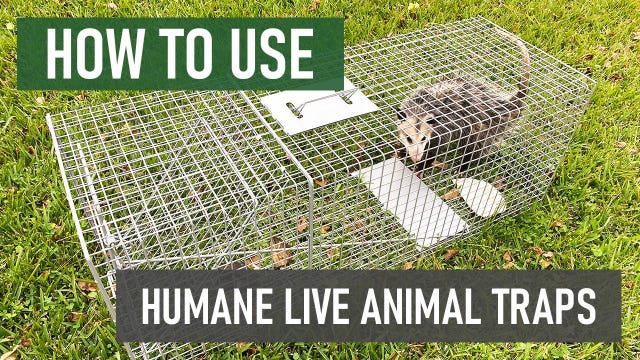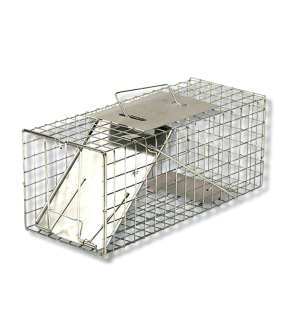Gain access to personalized product screening, the best pricing, rewards, and more!
Most Effective Products
How to Catch a Hare with a Live Trap
Some people may confuse a hare for a rabbit. While they may share characteristics such as size and diet, the hare is undoubtedly different. These animals can cause damage to any underground piping as well as vegetation in your yard or garden. One method of removing a hare from your property is using a live trap to catch and release the animal. Live trapping is a safe and effective way to keep animals away from your home.
If you want to catch a hare with a live trap, read this guide for instructions and product recommendations.
Identification
Before using a live trap, you must ensure the wild animal you are dealing with is a hare. This will ensure that you are using the correct bait and strategies.

Hares are generally 12 to 21 inches long. They are similar in appearance to rabbits, but they have larger ears. They normally weigh between 1.25 and 7 pounds. Hares are very fast and can run up to 40 miles per hour. They are mainly active during dawn and dusk, and their diet consists of grass, plants, and other vegetation.
Use the image and description above to confirm that you are dealing with a hare on your property.
Inspection
Once you've confirmed that your pest animal is a hare, it is helpful to recognize the areas where it is most active. This is where you will place your live trap.
Where to Inspect
You want to pick areas that have high activity from hares. These animals are most likely searching your property for food. Hares can usually be found in brush or wooded areas. However, they are adaptable animals and can also be found in parks and golf courses.
What to Look For
Damaged gardens and overturned vegetation are signs of hare damage. They can potentially chew on piping. You will also want to search for hare droppings and tracks. Droppings will look like several round, hard balls. Hare tracks will look like ovals with four toes.
Treatment
Now that you've identified your pest animal as a hare and noted areas where it is most active, you can use your live trap. Be sure to wear gloves when handling the trap to prevent leaving your scent. If a hare picks up a human scent on the trap, it will avoid it, making it ineffective.
Step 1: Remove Food Sources
You want the hare to enter the live trap with the help of bait. Because of this, competing food sources need to be removed. Keep your trash sealed in trash bags and stored in trash bins with a lid to keep it closed. Any pet food or water bowls should be placed inside as soon as possible.
Step 2: Place the Trap

By now, you should have taken note of areas with high hare activity. These areas are where you will put your trap. Be sure to place your trap on an even surface. A hare might push or knock over the trap to reach the bait inside. Place a brick or weight on top of the trap to avoid this.
Step 3: Bait and Set the Trap

Using the proper bait will increase your chances of catching a hare. You can use corn on the cob or dried apples. The bait should be placed near the back of the trap. This ensures the hare must step on the trigger plate to reach the food.
You will then set your trap by pushing on the door lock and lifting the door plate. Keep the door plate lifted while pulling the trigger arm forward to put it. You will know it is set when the trigger arm's hook catches the door.
Step 4: Monitor the Trap

You will need to check the traps twice a day, preferably once in the morning and once in the evening. This is when you will refill bait if necessary. Checking the trap frequently may dissuade hares from approaching it.
Do not keep an animal trapped in the cage for longer than 24 hours.
Step 5: Relocate the Hare
Any non-target animals should be released immediately. Once you have captured a hare in your live trap, check with your local authorities to ensure you correctly relocate the animal. Approach the trap slowly and use a gentle voice.
Place a towel over the cage to avoid frightening the hare. Once you have relocated far enough, carefully open the trap and release the animal. You can read more about releasing an animal from a live trap here.
Prevention
After using your live trap, you want to ensure that wild animals do not invade your property again. You can take some preventative measures to keep your area free of hares.
Sanitation
An unkempt yard will provide plenty of materials for a hare. Be sure to maintain your lawn regularly and get rid of weeds. Clean and remove debris, as well as piling and relocating any firewood.
Exclusion
If your property is near a wooded area and you have no fencing, you are more susceptible to having hares and other wild animals invade it. Consider blocking off your property with fencing. Be sure the fencing is taller than at least 2 feet so hares cannot jump over it.
Key Takeaways
- Hares are very similar to rabbits in appearance, but they have more prominent ears. These swift animals are most active at dusk and dawn. These adorable creatures can cause extensive damage to your yard.
- Bait the live trap with corn on the cob or dried apples, making sure it is placed behind the trigger plate of the trap.
- Check the trap once in the morning and once in the evening. Once a hare is caught, check with your local authorities to ensure you safely and correctly release it.
- Remove potential food sources and trash and regularly maintain your yard to prevent hares from entering your property again.








